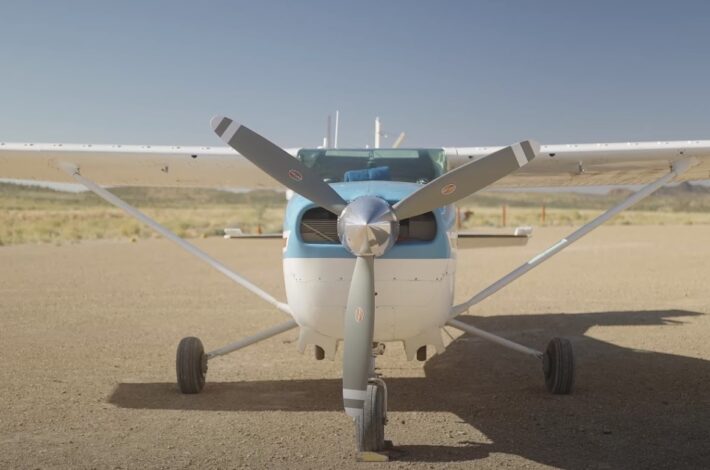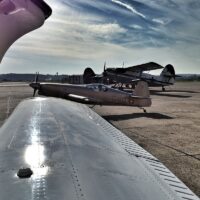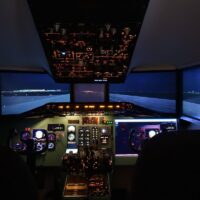
This article provides a meticulous exploration of the Cessna 207, a prominent member of the single-engine general aviation family, known for its fixed landing gear and roots in the esteemed Cessna 210 lineage. Its siblings, the Cessna 205 and 206, also belong to this robust and reliable family of aerial vehicles.
Uniquely, these three planes exhibit a sturdier build suitable for flying under tough conditions and in challenging terrain, distinguishing them from other popular airplane models like the 172 and 182. This hardiness has contributed to their reputation as reliable bush planes.
Unveiled in 1969, the 207 is a larger variant of the 206 model, designed to carry up to eight occupants, thanks to a lengthier fuselage. Initially christened the ‘Skywagon,’ it was rebranded as the ‘Stationair 7’ in 1977. The production run for this model ceased in 1984, culminating in a total of 626 units.
Its generous seating capacity has made the 207 a favorite among air taxi services, particularly for short-haul flights. Though not as common among private pilots due to their size and weight, those who operate them express satisfaction with the ample space it offers for passengers and luggage.
Specifications:
- External Measurements;
- Height: 9 ft 7 in;
- Wing Expanse: 35 ft 10 in;
- Aircraft Length: 32 ft 2 in;
Interior Measurements:
- Wing Area: 16.2 m² or 174 ft².
Capacity:
- Crew: 1;
- Passenger Capacity: 5 – 7;
- Operational Weights;
- Max Takeoff Weight: 3600 Lb;
- Operational Weight: 2522 Lb;
- Empty Weight: 2172 Lb;
- Fuel Holding: 534 Lb;
- Useful Payload: 1628 Lb;
- Payload with Full Fuel: 556 Lb;
- Max Payload: 1078 Lb.
Performance Statistics:
- Service Ceiling: 13300 ft;
- Takeoff Distance Required: 1100 ft;
- Balanced Field Length: 2100 ft;
- Landing Strip Requirement: 2358 ft;
- Climbing Rate: 950 fpm;
- Top Speed: 161 knots;
- Cruise Speed: 149 knots;
- Hourly Cost: $ 222.76;
- Power Plant;
- Engine Count: 1;
- Engine Manufacturer: Continental;
- Engine Model: IO-520-F.
Pricing
Given the 207’s production ended in 1984, all models currently available are pre-owned. Consequently, prices can vary significantly, contingent upon the age and condition of each individual unit:
- As per one estimate, the average price for a pre-owned 207 is around $159,000. However, there are cases where prices can go significantly higher, even up to $640,000;
- Lower-priced variants are also available, depending on the condition and specific model variant.
Performance and Handling
Often likened to a minivan of the skies, the 207 is recognized for its spacious interior capable of accommodating a large number of passengers and a considerable load:
- The aircraft is a sturdy, simple, single-engined machine, but it is larger and stronger than the models it is based on. This makes it an ideal choice for trips like a family skiing holiday, carrying everyone and their equipment comfortably;
- The significant weight of the 207 makes it resistant to turbulence, enabling a smoother flight in varying conditions. Its highly efficient flaps and superior slow-speed handling outperform many smaller models;
- When landing, adjusting the flaps, setting the nose slightly upwards, and letting the plane glide onto the runway makes for a smooth landing, a maneuver familiar to any Cessna 152 or 172 pilot. And in the absence of proper runways, a 1000 feet long flat stretch is all the 207 needs for a landing.
While it may not be a race-winning flyer, the 207 doesn’t disappoint when it comes to performance. The turbo version can reach true airspeeds of nearly 130 knots at low altitudes and 150 knots at higher altitudes. The naturally aspirated models show similar performance at low altitudes but fall short at higher ones.
Operational Costs
Operating and maintaining this airplane encompasses a variety of expenses that potential owners need to factor into their decision-making process. These expenses extend beyond the initial acquisition cost and can significantly affect the overall cost of ownership.
- Fuel: Arguably the largest ongoing operational cost, fuel expenditures are determined by both your typical flight parameters and the prevailing fuel prices in your area. Flights involving long distances or heavy payloads will naturally consume more fuel. Moreover, fluctuations in global and local fuel markets can influence the cost of aviation fuel.
- Maintenance: Consistent upkeep forms a crucial aspect of aircraft ownership. This includes routine maintenance tasks, such as periodic oil changes, mandatory annual inspections, and setting aside funds for eventual engine overhauls. Unscheduled maintenance arising from wear and tear or unexpected breakdowns can also lead to substantial costs.
- Insurance: Insurance premiums, as noted earlier, can vary significantly based on the aircraft’s condition and the experience level of the pilot(s). This cost element should be carefully considered when estimating the total operational expenditure.
- Hangarage: Securing a safe and suitable place for the aircraft when it’s not in use is vital. Hangar or tie-down costs will depend on your location and the available options at your local airport or airfield.
- Pilot Training: When transitioning from a smaller aircraft to a Cessna 207, it may be necessary to invest in further flight training to ensure the safe and competent operation of the larger, more complex model.
Life Cycle and Durability
Built to stand the test of time, the 207 consistently outlives many aircraft of a similar class, reflecting the craft’s unwavering focus on longevity. This quality can be credited to the rigorous construction standards followed during its assembly and the incorporation of first-rate materials.
- Airframe: The airframe of the 207, forged from robust aluminum, is devised to withstand extensive use over a prolonged period. Meticulous maintenance plays a pivotal role in the longevity of the airframe. This includes regular inspections to detect any signs of corrosion, stress fractures, or other forms of structural wear and tear. Timely identification and remediation of these issues are vital for maintaining the airframe’s integrity and ensuring a prolonged service life.
- Engine: The aircraft’s engine, constructed with resilient components, is capable of delivering dependable performance for countless flight hours. Maintenance of the engine should be proactive and routine to avoid premature deterioration and the financial burden of premature overhauls. Regular oil changes, periodic inspections for wear and tear, and close monitoring of engine performance metrics are essential practices for extending the engine’s lifespan.
Flight Characteristics
The Cessna 207 enjoys a stellar reputation for its consistent, predictable flight behavior, endearing it to a wide range of pilots, from novices to seasoned veterans.
- Load Capacity: The craft’s remarkable load-bearing capacity makes it an unparalleled choice for transporting substantial loads. Whether it’s outdoor enthusiasts with bulky gear, families embarking on vacation with hefty luggage, or logistics operators needing to ferry sizable cargo, the 207 stands ready to serve.
- Stability: The plane is celebrated for its unflappable stability during cruise phases and its manageable, docile nature during stall scenarios. These attributes enhance its appeal among pilots, offering an additional layer of comfort and confidence during flight operations.
- Handling: Despite its increased weight requiring heightened attention during landing phases, the 207’s handling traits are largely congruous with those of its smaller Cessna counterparts. However, due to its more substantial heft and rugged construction, pilots might perceive a subtle difference in handling, necessitating an adjustment period for those transitioning from lighter Cessna models.
Safety Features
Constructed with a paramount focus on safety, the 207 incorporates a multitude of features designed to protect its occupants and itself during the rigors of flight.
- High Wing Design: This design choice offers dual advantages. It affords superior visibility, enabling pilots to better assess their surroundings during flight. Additionally, it provides increased protection from ground obstacles during take-off and landing phases, reducing the risk of inadvertent collisions.
- Fixed Landing Gear: The solid, fixed tricycle landing gear is built to endure the rigors of rough terrain, attesting to the aircraft’s versatility and suitability for operations in demanding environments. This attribute broadens the operational scope of the 207, allowing it to access remote areas and unimproved landing strips.
- Effective Flaps: The airplane is fitted with exceptionally effective flaps that augment its slow-speed handling characteristics. These flaps greatly enhance the aircraft’s operational versatility, enabling it to utilize shorter runways and execute stable, controlled landings with ease.
Preservation Plan
Upkeep for the 207 aligns closely with the procedures for other single-engine Cessna models, making it manageable for an owner to maintain:
- Similar to several other models, the 207s are inclined to develop fissures in the doorposts – an issue owners should regularly monitor;
- Another area to inspect regularly is the wear and tear in the seat tracks, as this can lead to the sudden and unexpected rearward movement of the pilot’s seat during takeoff, which could result in dangerous situations. It’s a common problem across several models.
Despite these minor issues, no major problems are typically associated with this model. Even though the 207 is an older model, service manuals are easily accessible, and it is an aircraft most mechanics are well-versed in.
Enhancements and Improvements
Soloy Aviation Solutions provides a turboprop conversion for some Cessna 207 models. Over the years, there have been several model variants. The initial 207 Skywagon boasted seven seats and was powered by a Continental IO-520-F engine. This was succeeded by the T207 Turbo Skywagon, featuring a turbocharged engine.
The 207A Skywagon/Stationair 8 followed, initially with seven seats, but an eight-seat certification was obtained in September 1979. Lastly, we have the T207A Turbo Skywagon/Turbo Stationair 8, which was a turbocharged adaptation of the prior variant. Therefore, there is a diverse selection to choose from.
Locating Spare Parts
Owners report that finding parts for the 207 has become progressively more expensive, likely due to the model’s rarity. While it’s not exactly a commonplace flying machine, the production span was sufficiently long to ensure a reasonable availability of used and reconditioned parts if you search meticulously.
A simple internet search reveals numerous companies offering these parts, with some even available on online auction platforms like eBay.
Typical Issues
The 207 shares the same reliability as the 205 and 206 models, exhibiting few standard issues. It’s essentially a simple, single-engine flying machine, known for its stability during cruising and gentleness during stalls, much like many other models.
However, planning is crucial when embarking on a long voyage with a full load of passengers or cargo. The 207 can either be filled to the brim with fuel or can carry a full payload of passengers and luggage, but doing both simultaneously is not feasible. This, however, is a common characteristic among several flying machines and is not unique to the 207.
Moreover, careful consideration should be given to shorter runways as the 207 is not designed for short-field landings. A substantial amount of landing space is needed, which some pilots may find challenging.
Insurance Alternatives
As with all flying machine insurance, coverage is divided into two parts. There’s liability coverage that provides protection against damages caused by the plane to people or property, and optional hull insurance, which covers damage or loss of the plane itself.
The insurance cost varies significantly, depending on the plane’s condition and the pilot’s experience. Hence, providing an exact figure for the insurance cost for any model, especially a rather rare one like the 207, is challenging. However, one insurance provider quotes an average annual insurance cost of $2860 for a 207, divided into $1100 for liability coverage and $1760 for hull insurance. This is likely a ballpark figure, but it’s crucial to note that it’s just a rough estimate.
Reselling Prospects
Several factors can affect the resale value of an aircraft, including total airframe hours, the time elapsed since the engine was overhauled, onboard equipment, maintenance history, damage history, and overall condition of the plane. The good news is, these elements largely fall under the purview of the owner. It’s well recognized that meticulous care and maintenance are paramount if you aim to get a desirable resale price for your Cessna 207 or any aircraft, for that matter.
A point in the 207’s favor is its relative rarity. This scarcity indicates that its value will likely remain robust, assuming there remains a demand for this model. Its appeal to a particular subset of pilots seems to be enduring, which is a positive signal.
User and Operator Feedback
The general sentiment from reviews of the Cessna 207 centers on its impressive power and commendable payload capability. However, users readily acknowledge that it is not a ‘one-size-fits-all’ solution:
- One operator praised the 207’s exceptional capacity for carrying heavy loads and accommodating bulky luggage. They also remarked on its stellar performance on rugged terrains. They cautioned, though, that the 207 is not a short-field aircraft. It demands a higher level of vigilance and maneuvering finesse compared to lighter models like the Cessna 206;
- Another owner underscored the 207’s impressive lifting ability as a standout feature. A third, with significant flight experience on the 207, noted that while it excels at sea level, its performance can wane at higher altitudes. He, however, conceded that the turbo version offers superior performance and versatility at these elevations.
In essence, the 207 is a reliable heavy-duty carrier, but it needs to be operated within its defined limitations.
Comparable Models
The roster of sturdy, high-capacity aircraft like the 207 is relatively limited. Naturally, it shares many similarities with its family members, namely the Cessna 205 and 206. Its handling has been compared to the Cessna 172 and 182.
However, the Cessna 207’s increased weight and rugged build mean that transitioning from a smaller Cessna model to the 207 might require additional training and practice.
Affiliated Associations
Cessna owners can consider joining the Cessna Pilots Association, accessible at cessna.org/. There are also special community groups on social media platforms like Facebook, along with various regional and local aviation organizations that 207 owners can explore.
| Key Takeaways | Details |
|---|---|
| Model History | The Cessna 207 was produced between 1969 and 1984, with a total of 626 units made. |
| Specifications | It can seat 5-7 passengers, with a maximum takeoff weight of 3600 lbs. Its cruise speed is 143 knots. |
| Maintenance and Upgrades | Regular maintenance is crucial. Soloy Aviation Solutions offers a turboprop conversion for some 207 models. |
| Resale Value | Factors like total airframe hours, engine hours since overhaul, and aircraft condition influence resale value. The 207’s rarity potentially maintains its value. |
| Operational Costs | The major costs of owning and operating a Cessna 207 include fuel, maintenance, insurance, hangarage, and pilot training. |
| Life Cycle and Durability | The robust construction of the 207 contributes to its long life span. |
| Flight Characteristics | Known for its stability during cruises, gentleness during stalls, and impressive load-carrying capability. |
| Safety Features | The Cessna 207 is equipped with features such as a high-wing design, fixed landing gear, and effective flaps for enhanced safety. |
Final Thoughts
The Cessna 207 emerges as a versatile and dependable aircraft, aptly compared to an airborne minivan. Its exceptional load-carrying capacity, proven durability, and robust safety features make it a preferred choice among a niche group of pilots and operators. While it may not offer high-speed or aerobatic prowess, it stands out in its ability to reliably carry substantial cargo over long distances and withstand harsh environments.
Given its relative rarity and enduring demand, it tends to hold its value well, making it a potentially sound investment. Anyone seeking an aircraft with these unique qualities will find the Cessna 207 to be a compelling option.
As with any aircraft, potential owners must be mindful of the operational costs, and be prepared for some additional training if transitioning from a smaller aircraft. However, for those who choose the Cessna 207, they are likely to join the ranks of pilots who have a fondness for this rugged, reliable aircraft.
FAQ
The primary differentiation between the two lies in their dimensions and seating capacity. The Cessna 207, being larger, is 45 inches longer than the 206 and is designed to house seven or eight passengers. While some pilots assert that these differences impact handling, others view the 207 merely as an extended version of the 206.
With a cruising speed of 143 knots and a maximum velocity of 150 knots, the Cessna 207 offers a quicker journey compared to the Cessna 172 or 182, though it’s not geared for competitive speed.
Undoubtedly! The Cessna 207 is an excellent choice for such transportation needs, as well as hauling gear for sports such as skiing or golfing. Its design accommodates such heavy-duty load-carrying assignments.
No, unlike the ongoing production of the Cessna 206, the Cessna 207 ceased production in the 1980s. However, numerous 207s continue to be operational today.
Most pilots find the shift to be relatively manageable. While there are similarities in handling between the models, the increased weight and robustness of the 207 suggest that additional training would be prudent before flying a Cessna 207 for the first time. The transition, however, is not overly burdensome.

